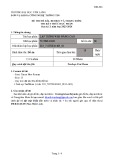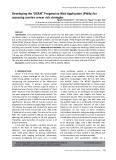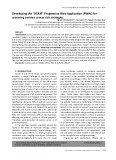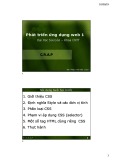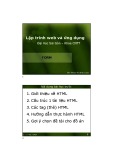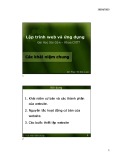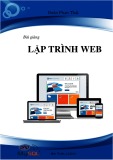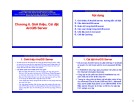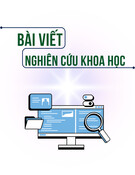ASP.NET MVC
Nguyen Ha Giang
Introduction
Overview of Web Application Development
Introduction to ASP.NET MVC
Architecture of ASP.NET MVC App
Creating an ASP.NET MVC Project
Structure of an ASP.NET MVC Project
Overview of Web Application Development
Web Application
from a Web browser.
Are programs that are executed on a Web server and accessed
that can be accessed globally at any time.
Allows you to share and access information over the Internet
commerce application.
Enable you to perform commercial transactions known as E
Web Application Layers
Web apps are typically divided into 3 layers:
Presentation layer: Enable users to interact with the app
Business logic layer: Enables to control the flow of execution and communication between the presentation layer and data layer.
business logic layer.
Data layer: Enables to provide the app data stored in DBs to the
Web Application Layers
Data Layer
Presentation Layer
Business Logic Layer
Web App Architectures
Architecture of an application depends on the system in which the layers of the application are distributed and communicated to each other.
An application can be based on one of the following
types of architectures:
Singletier: In this architecture, all the three layers are integrated together and installed on a single computer.
over two tiers, a client and a server.
Twotier: In this architecture, the three layers are distributed
Threetier: In this architecture, the three layers of the application are distributed across different computers.
further separated.
Ntier: In this architecture, the components of the threetier are
Types of Web Pages
A Web app consists of Web pages.
A Web page can be categorized on the following two
types:
users
Static Web page: Consist of only HTML to present content to
Dynamic Web page: Consists of HTML in combination with serverside and clientside scripts to respond to user actions.
Evolution of ASP.NET MVC
ASP.NET MVC is a framework for developer dynamic
Web app using the .NET Framework
Prior to ASP.NET MVC, dynamic Web app based on
the .NET Framework were developed using the following:
ASP.NET Web Forms
ASP.NET Web Pages
ASP.NET Applications
ASP.NET
Web applications using advanced features.
Is a serverside technology that enables you to create dynamic
side and serverside scripts to build dynamic Websites.
Are comprised of .aspx Web pages that combine both client
Web server for the Windows platform
App can deployed on a Web server such as IIS, which is the
ASP.NET Applications
The requestresponse process for an ASP.NET Web
page contains the following steps:
Browser sends a request for an ASP.NET Web page.
loads the requested file, and forwards it to the ASP.NET runtime for processing.
When the request arrives, the IIS server intercepts the request,
processes the requested ASP.NET page and generates the response.
The ASP.NET runtime that contains the ASP.NET script engine
requested the page.
The IIS server sends back the response to the Web server that
ASP.NET Applications
Following figure shows the requestresponse flow for
an ASP.NET Web page:
IIS Web Server
ASP.NET Runtime
1
2
3
Browser
4
ASP.NET Web page
ASP.NET Web Forms
The traditional ASP.NET Web app gradually evolved to ASP.NET Web Forms to simplify development of dynamic Web app.
In ASP.NET Web Forms:
your UI.
You can drag and drop User Interface (UI) controls to design
runtime.
ASP.NET Web Forms:
You can specify how the form and its control should respond at
allows users to request through browser.
Uses a combination of HTML, server controls, servercode, and
Does not require you to have a hardcore developer background.
and handle the development environment created for HTML
elements easily.
Allows you to use CSS, generate semantically correct markup,
ASP.NET MVC
Based on the MVC design pattern that allows you to
develop software solutions.
MVC design pattern:
components
Allows you to develop Web App with loosely coupled
from each other.
While using the MVC design pattern, a Web app can
Enable separating data access, business, and presentation logic
be divided into following types:
app data of a Web app.
Model: Represents information about a domain that can be the
the model.
View: Represents the presentation logic to provide the data of
between the view and model classes.
Controller: Represents the logic responsible for coordination
ASP.NET MVC
Following figure shows the communications between
the model, view and controller components:
View
View
Controller
Model
ASP.NET MVC
As ASP.NET MVC is based on the MVC design
pattern, it provides the following benefits:
Separation of concerns: Enables you to ensure that various app concerns into different and independent software components.
component independently. Thus, it allows you to ensure that it is working as per the requirement of the app and then, simplifies the process of testing, maintenance, and troubleshooting procedures.
Simplified testing and maintenance: Enable you to test each
Extensibility: Enables the model to include a set of independent components that you an easily modify or replace based on the app requirement.
History of MVC
The versions that depict the history of MVC are as
follows:
Architecture of ASP.NET MVC App
The basic architecture of an ASP.NET MVC app
involves the following components:
MVC Framework
Route engine
Route configuration
Controller
Model
View Engine
Each of these preceding components communicates
View
to process requests coming to an ASP.NET app.
The process of handling an incoming request involves
a series of steps that these components perform.
Architecture of ASP.NET MVC App
The steps that the components of the ASP.NET MVC Framework performs while handling an incoming request includes:
The browser sends a request to an ASP.NET MVC app.
engine.
The MVC Framework forwards the request to the routing
an appropriate controller to handler the request.
The route engine checks the route configuration of the app for
an error to the browser
When a controller is found it is invoked When a controller is not found (cid:0)
The controller communicates with the model
data of the model.
The controller requests a view engine for a view based on the
The view engine returns the result to the controller
browser
The controller sends back the result as an HTTP response to the
Architecture of ASP.NET MVC App
1
2
3
Route Engine
Route Configuration
5
Browser
?
4
9
6
Controller
Model
7
8
View Engine
Supporting Technologies
ASP.NET MVC app support various technologies to
create dynamic and responsive Web app.
Some of the supporting technologies that you can use while creating an ASP.NET MVC application are as follows:
JavaScript
JQuery
AJAX
IIS
Windows Azure
JavaScript
Is a clientside scripting language that enables a Web app to respond to user requests without interacting with a Web server.
Allows creating responsive Web app that enhances
user experience.
Allows implementing functionalities, such as an easy to use UI, quick response to user’s request, and run in all available browsers.
Allows your Web applications to respond to user requests without interacting with a Web server.
jQuery
JQuery:
Is a JS library that simplifies the clientside scripting of HTML
Is used in views to make your views responsive and dynamic
Allows you to perform clientside validation of forms
elements of a view.
When you create an ASP.NET MVC project in VS
Provides several plugins that enable you to enhance the UI
2013, the project automatically includes the jQuery libraries within the Scripts folder.
jQuery
Following figure shows the
jQuery libraries in the Scripts folder of an ASP.NET MVC project
jQuery
To use a jQuery library in a view, you need to refer
the library from the view.
You can use the following code snippet to refer to a
JQuery library from a view:
AJAX
AJAX:
apps.
Is a Web development technique that is used to create interactive
Allows you to asynchronously retrieve data in the background of an ASP.NET MVC app without interfering with the display and behavior of the existing view.
without being affected by the responses received from the server
Enables the users to work continuously on the application
AJAX
JS forms an integral part of the AJAXenabled Web
Apps because these apps process most of the requests on the client side, unless there is a need to connect to the Web server.
The XMLHttpRequest object is one of the primary
objects used by JS because it enables asynchronous communication between the client and the server.
MVC Support in VS 2013
Visual Studio 2013
providing various inbuilt templates.
Simplifies the process of creating ASP.NET MVC applications by
application structure with the basic files to run the app
Provides an MVC template that automatically creates an MVC
Creating an ASP.NET MVC Project
To create an ASP.NET MVC app using VS 2013, you
need to perform the following tasks:
menu bar of VS 2013.
In VS 2013, click File >New >Project menu options in the
the Installed section and then, select the ASP.NET Web Application template, as shown in the following figure:
In the New Project dialog box that appears, select Web under
Creating an ASP.NET MVC Project
Creating an ASP.NET MVC Project
Type MVCDemo in the name text field.
Click OK. The new ASP.NET Project – MVCDemo
dialog box is displayed.
Select Basic under the select a template section of the
New ASP.NET MVC 4 Project
Creating an ASP.NET MVC Project
Click OK. VS 2013 displays the newly created app, as
shown in the following figure
Structure of an ASP.NET MVC Project
When you create an ASP.NET MVC Web app in VS 2013, it automatically adds several files and folders to the project.
Following figure shows the files and folders that VS 2013 creates when you create an ASP.NET MVC app.
Structure of an ASP.NET MVC Project
The toplevel directory structure of an ASP.NET MVC
app contains the following folders:
request
Controllers: contains the controller classes that handle URL
data and business objects.
Models: contains the classes that represent and manipulate
rendering output, such as HTML.
Views: Contains the UI template files that are responsible for
Scripts: Contains the JS library files
Images: Contains the images that you need to use in your app
Content: Contains the CSS and other site content.
Filters: Contains the filter code.
App_Data: Contains data files that you need to read/write
that you
can use features like Routing, Bundling, and Web
API.
App_Start: Contains the files containing configuration code
Summary
Web app are programs that are executed on a Web
server and accessed from a Web browser.
Web app are typically divided into 3 layers, where
each layer performs different functionalities.
The architecture of an app depends on the system in
which the layers of the app are distributed and communication to each other.
ASP.NET is a serverside technology that enables you to create dynamic Web app using advanced features, such as simplicity, security, and scalability, which are based on the .NET Framework.
ASP.NET MVC is based on the MVC design pattern
that allows you to develop software solutions.
An ASP.NET MVC app requires a Web server that





